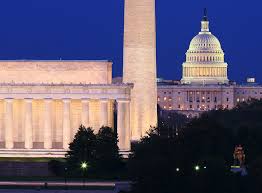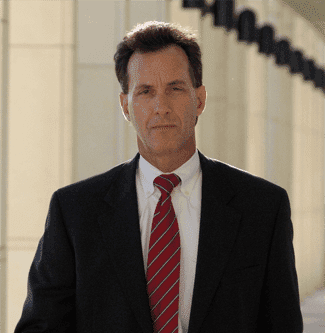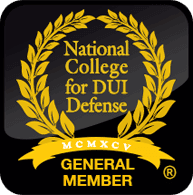I’ve been remiss. Like my fellow defense attorneys I habitually keep my head buried in court appearances, case law and statutes, cross examination preparation, closing arguments, and
customer service. I’ve been remiss because the daily grind has so easily diverted me from reflecting on a deeper meaning in this work. Namely, safeguarding the great American experiment. The grand experiment of representative government in a free self-governing society. Indeed, our work defending individuals has been at the core of safeguarding this experiment. We protect individual liberty and freedom. Values our founding fathers determined were most vital to a free society. And, until a recent trip to our Nation’s capital with my family, I failed to take stock of the sacrifices made to protect this experiment. What unfolded was a new and solemn awareness of the sacrifice free individuals have made to protect our representative democracy. I couldn’t help but desire that every criminal defense attorney share in this appreciation.
While riding the D.C. Metro Red Line into the city we looked forward to three days of sight-seeing. We anticipated visiting the Smithsonian Air and Space Museum, the National Museum of Natural History, and the National Gallery of Art. However, I was unprepared for our trip’s visceral impact. Maybe it was my age. Maybe it was watching my children get better acquainted with their country’s foundational principles. Maybe it was my calling as a lawyer. But beginning with the 12 minute U.S. Capitol Building tour orientation movie, I was overwhelmed with gratification for our experiment in democratic self-governance. Our Nation’s birth was called to mind at the Capitol Building. Out of such different perspectives, out of such distinct personalities, out of so many free and fiercely independent people emerged but one country . . . one Nation. Out of that independence flowed energy, ideas, and passionate differences. Differences resolved and common ground secured after consideration of many points of view. Creating a government of the people, by the people, and for the people.1 Where all voices were taken into account, not just those of the majority. And what was the price paid for becoming an independent people? The blood of soldiers and the sacrifice of families.
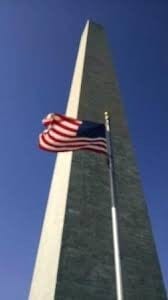 George Washington’s gallantry in leading his Continental Army to victory over the British opened the door for our great American experiment. Fittingly, the Washington Monument may be the most iconic structure on the National Mall. Its grandeur strikes one as timeless. Though recognizable from many areas of the city, there’s no call to ride the elevator to the top to fathom its grandeur. One need only stand at the base and look skyward to grasp the majesty of this marble obelisk towering almost 555 feet above the Mall. Even the Great Pyramid of Giza is shorter at 481 feet.2 The monument was completed in 1888 to commemorate our Nation’s first President and his service as commander-in-chief. Though my children were content with slapping the monument’s foundation, I leaned back and strained to find the capstone profiled against a stunningly deep amethyst-blue sky. I couldn’t help but hold in regard the young lives given to secure the individual freedoms we work daily to defend.
George Washington’s gallantry in leading his Continental Army to victory over the British opened the door for our great American experiment. Fittingly, the Washington Monument may be the most iconic structure on the National Mall. Its grandeur strikes one as timeless. Though recognizable from many areas of the city, there’s no call to ride the elevator to the top to fathom its grandeur. One need only stand at the base and look skyward to grasp the majesty of this marble obelisk towering almost 555 feet above the Mall. Even the Great Pyramid of Giza is shorter at 481 feet.2 The monument was completed in 1888 to commemorate our Nation’s first President and his service as commander-in-chief. Though my children were content with slapping the monument’s foundation, I leaned back and strained to find the capstone profiled against a stunningly deep amethyst-blue sky. I couldn’t help but hold in regard the young lives given to secure the individual freedoms we work daily to defend.
As we moved to other memorials each seemed to capture an ardent feeling or idea. The National World War II Memorial was no different. It evinced victory in a conflict of global proportions. Consisting of 56 granite pillars and two triumphal Atlantic and Pacific arches surrounding a 7.4 acre plaza and fountain, it was dedicated to Americans who served in the armed forces during World War II. Its expanse made known the physical distances overcomed to vanquish tyranny and defend individual freedom. Visitors walked along two walls picturing scenes of the war experience in bas-relief; scenes of servicemen receiving medical exams, young men taking the oath, and soldiers being issued military gear. There were scenes of invasion, combat, and burying the dead – all ending in a scene of homecoming. Elegant water fountains poured forth affording thoughts of triumph and peace.
The Vietnam Veterans Memorial was unique as it imparted neither defeat, nor triumph . . . but simply sacrifice. The “Wall” was sunk into the ground with the earth behind over fifty-eight thousand names etched into black granite honoring U.S. service members MIA and killed in action. Fresh flowers and wreaths adorned it. Visitors walked down below ground level to view the names of each member lost and the chronological order of their falling. A volunteer stood prepared to help visitors locate the name of a friend or loved-one. The names started at the apex on panel 1E in 1959 moving day-by-day to the end of the eastern wall at panel 70E. They started again at panel 70W and continued to the apex at panel 1W in 1975. The muted simplicity of the Wall stood in stark contrast to the memorial honoring our WW II veterans.
thousand names etched into black granite honoring U.S. service members MIA and killed in action. Fresh flowers and wreaths adorned it. Visitors walked down below ground level to view the names of each member lost and the chronological order of their falling. A volunteer stood prepared to help visitors locate the name of a friend or loved-one. The names started at the apex on panel 1E in 1959 moving day-by-day to the end of the eastern wall at panel 70E. They started again at panel 70W and continued to the apex at panel 1W in 1975. The muted simplicity of the Wall stood in stark contrast to the memorial honoring our WW II veterans.
The war between the States may have posed the greatest risk to our experiment in representative democracy. The Lincoln Memorial honored our 16th President’s courageous leadership during this precarious moment in history. It contained a large seated white marble sculpture of Abraham Lincoln standing 19 feet high and weighing 175 tons.3 Lincoln’s second inaugural address was chiseled into the wall of the north side chamber. The Gettysburg Address was hewed into the wall of the southerly chamber paying tribute to the soldiers who died in that pivotal battle. Remarkably, reciting the address aloud to my children breathed life into Lincoln’s words. The beauty and power of the rhetoric was penetrating. As I read, I pondered how easy the North and South could have parted and gone their separate ways. But Lincoln’s leadership and the sacrifice of both Union and Confederate soldiers ensured the great American experiment would endure. I doubt many of those young men understood their significance. Though, it’s now easy to recognize their deaths assured the survival of our Republic.
Visiting the National Archives and waiting to study the original Declaration of Independence, United States Constitution, and Bill of Rights, I was stirred once again. In the Rotunda these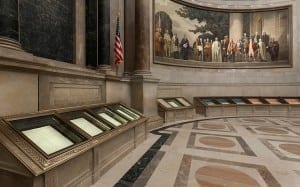 documents stood slightly elevated, under armed guard, and locked in encasements constructed by the National Institute of Standards and Technology of titanium and aluminum.4 The frames were gold plated and one observed the documents through bullet-proof glass. Though shielded, the original documents have faded markedly over time. Consequently, the lights were dimmed to protect the parchment from further detriment. While standing with my children, listening to the armed guard’s instructions and waiting our turn, it struck me. Each day of life as a lawyer I press into service these same treasured documents – protecting those individual liberties our founding fathers deemed so fundamental. Most importantly, I grasped my responsibility in safeguarding these liberties. Liberties imparted through our experiment in self-governance and a responsibility I proudly share with all criminal defense lawyers.
documents stood slightly elevated, under armed guard, and locked in encasements constructed by the National Institute of Standards and Technology of titanium and aluminum.4 The frames were gold plated and one observed the documents through bullet-proof glass. Though shielded, the original documents have faded markedly over time. Consequently, the lights were dimmed to protect the parchment from further detriment. While standing with my children, listening to the armed guard’s instructions and waiting our turn, it struck me. Each day of life as a lawyer I press into service these same treasured documents – protecting those individual liberties our founding fathers deemed so fundamental. Most importantly, I grasped my responsibility in safeguarding these liberties. Liberties imparted through our experiment in self-governance and a responsibility I proudly share with all criminal defense lawyers.
Regrettably, there was much we didn’t have time to see. The Arlington National Cemetery. The Korean War Veterans Memorial. The Martin Luther King, Jr. Memorial. The Library of Congress. The Supreme Court. The trip was, nonetheless, impactful. It inspired me. It imparted new zest into my daily work. It made me proud to be an American again. And I realized how our lawyering defends our democracy. A democracy paid for with the blood of soldiers and the sacrifice of families. I trust each of you may visit our Nation’s capital to more fully appreciate your own responsibility in keeping safe our great American experiment of representative self-government.
1. “The Gettysburg Address by Abraham Lincoln.” The Gettysburg Address by Abraham Lincoln. Abraham Lincoln Online, 2016. Web. 10 Jan. 2016. <http://www.abrahamlincolnonline.org/lincoln/speeches/gettysburg.htm>.
2. Millmore, Mark. “Pyramids of Giza.” Discovering Ancient Egypt. Eyelid Productions, 2016. Web. 7 Jan. 2016. <http://discoveringegypt.com/pyramids-temples-of-egypt/pyramids-of-giza/>.
3. United States. National Park Service. “Lincoln Memorial.” National Parks Service. U.S. Department of the Interior. Web. 8 Jan. 2016.<http://www.nps.gov/nr/travel/wash/dc71.htm>.
4. “NARA – The Declaration of Independence – Our National Treasure.” National Archives and Records Administration. National Archives and Records Administration. Web. 8 Jan. 2016. <http://www.archives.gov/exhibits/charters/treasure/declaration_facts.html>.
(“Off the Back” featured in the “Voice For The Defense” January/February 2016)
Stephen Gustitis is a criminal defense lawyer in Bryan-College Station. He is Board Certified in Criminal Law by the Texas Board of Legal Specialization. He is also a husband, father, and retired amateur bicycle racer.
“Off the Back” is an expression in competitive road cycling describing a rider dropped by the lead group who has lost the energy saving benefit of riding in the group’s slipstream. Once off the back the rider struggles alone in the wind to catch up. The life of a criminal defense lawyer shares many of the characteristics of a bicycle rider struggling alone, in the wind, and “Off the Back.” This column is for them.


